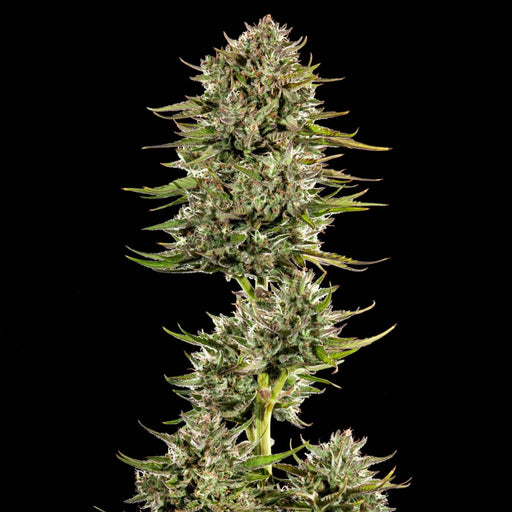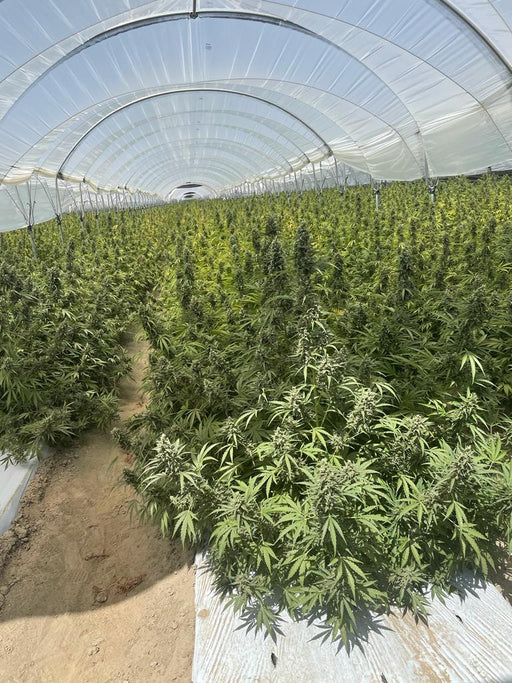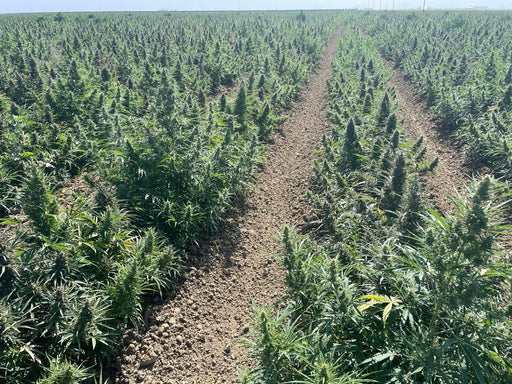
Tetraploid vs. Diploid Cannabis: A Grower's Guide
For a long time, cannabis cultivation operated in the shadows, lagging behind the genetic advancements seen in mainstream agriculture. That's changing fast. One of the most exciting developments is in the field of polyploidy—the science of creating plants with more than the standard two sets of chromosomes. This isn't just a minor tweak; it's a fundamental shift in what's possible for growers. To really get a handle on this revolution, you need to understand the core concepts, starting with the tetraploid vs diploid comparison. This article will explain the role chromosomes play in plant development and show how triploid and tetraploid varieties are setting a new standard for resilience, vigor, and yield.
In this article, we cover one of the most exciting developments in cannabis genetics – triploid and tetraploid cannabis strains. You’ll learn the role chromosomes play in plant development and how triploid varieties are revolutionizing the cannabis industry.
A Quick Guide to Cannabis Chromosomes
Chromosomes are small structures within the nucleus of a cell that contain genetic information. Most organisms, like humans and cannabis, have two sets of chromosomes in each cell. They store genetic information for mitosis, the process of copying DNA during cell division.
Understanding Diploid Cannabis: The Genetic Standard
The standard cannabis genome is made up of plants with two sets of chromosomes, known as diploids. Each diploid plant has 20 chromosomes, ten from each parent. Plants with sets of chromosomes help specific traits survive and adapt better to their environment. Not only is there another chromosome in case one gets damaged, but plants can benefit from desirable characteristics from each parent.
If having a set of chromosomes is more desirable than one, three or four would be even better. The problem is that cannabis plants with more than two sets of chromosomes are extremely rare in nature. However, due to recent advancements in cannabis genetics, polyploidy is possible and available to growers and breeders.
Tetraploid vs. Diploid: What’s the Real Difference?
Polyploid plants are nothing new in agriculture. Farmers have utilized the resilience of polyploid crops for centuries, including wheat, cotton, potatoes, and coffee. Cannabis genealogists have just recently stabilized varieties with over two sets of chromosomes through breeding diploid and naturally occurring polyploid strains.
Triploid and Tetraploid cannabis plants possess over two sets of chromosomes in each cell. As the names suggest, triploid has three sets (30 total), and tetraploid has four (40 total). Triploid cannabis plants pass on a set from one parent and two sets from the other, while tetraploid pass along two from each parent.
How Polyploidy is Created in Plants
Creating polyploid plants isn't a random occurrence; it's a result of careful scientific intervention. The process typically starts with a standard diploid plant. Breeders can use specific treatments to encourage the plant's cells to double their chromosomes, transforming a diploid (two sets) into a tetraploid (four sets). Once a stable tetraploid is established, it can be crossed with a diploid plant. The resulting offspring inherits two sets of chromosomes from the tetraploid parent and one set from the diploid parent, creating a triploid with three complete sets of chromosomes. This innovation is at the heart of what we do, allowing us to develop robust triploid cannabis varieties that offer unique advantages for cultivators.
Cellular and Physical Characteristics
The addition of extra chromosome sets does more than just change a number in a lab report; it leads to tangible differences in the plant's biology and physical form. These genetic modifications influence everything from the size of the plant's cells to its overall structure and growth patterns. For a grower, these changes are significant, affecting how the plant looks, feels, and performs in a cultivation environment. Understanding these characteristics helps you appreciate why polyploids are becoming so popular and how you can use their unique traits to your advantage, whether you're growing indoors or outdoors.
Plant Structure and Growth Habit
One of the most noticeable differences in polyploid plants is their structure. According to research in agriculture, "Tetraploid plants have larger cells, a higher ratio of soluble carbohydrates (sugars) to cell wall (fibre) and a higher water content." This translates to visibly thicker stems, larger leaves, and a generally more robust plant. This sturdy frame is excellent for supporting dense, heavy flower development later on. Furthermore, many polyploids tend to have a more open and upright growth habit. This structure allows for better light penetration and air circulation throughout the canopy, which can reduce the risk of mold and mildew in your indoor grow.
Seed Size and Planting Considerations
When you handle diploid and polyploid seeds, you might notice a difference in size. Diploid seeds are typically smaller, and as agricultural studies note, "They have more seeds per kilogram and grow more shoots, making them denser and stronger." This density can be useful in certain applications. In contrast, polyploid seeds are often larger. While you may get fewer seeds per gram, each one carries the genetic potential for a more vigorous and uniquely structured plant. When you shop for seeds, the focus shifts from quantity to the quality and performance of each individual plant, which is where polyploids truly shine.
Nutritional Quality and Palatability in Agriculture
The science behind polyploidy has been leveraged in mainstream agriculture for years, long before it was applied to cannabis. Farmers growing crops for animal feed, like ryegrass, discovered that polyploid varieties offered superior nutritional quality. The same cellular changes that make the plants more robust also alter their internal composition. By looking at these established applications, we can get a clearer picture of the potential benefits for cannabis and hemp cultivation. These principles, such as changes in sugar and fiber content, can influence everything from plant vigor to the final chemical profile of the harvest.
Suitability for Hay and Silage
In farming, the higher nutritional value of polyploids makes them a top choice for creating animal feed. For example, "Tetraploid Ryegrass is ideal for silage. Their higher sugar content is important for the fermentation process needed to make good silage." This higher concentration of soluble carbohydrates makes the plant more palatable and easier for animals to digest. For cultivators of industrial hemp, especially those growing for biomass or feed, this trait is a game-changer. It means the harvested material is not only more substantial but also of a higher quality for processing and consumption.
Farming Applications and Management
Knowing the genetic makeup of your plants is key to managing them effectively. The differences between diploid and polyploid varieties go beyond appearance and extend to how they respond to their environment and cultivation techniques. Whether you're managing a few plants in a tent or acres of them in a field, understanding these distinctions will help you tailor your approach. From watering schedules to training techniques, the unique characteristics of polyploids call for slightly different management strategies to help them reach their full potential and deliver the best possible results.
Durability and Grazing Resistance
Diploid plants are known for their toughness. Their growth habit results in a "thicker grass cover...making them denser and stronger," which allows them to withstand stress and bounce back quickly. This makes them incredibly reliable. Polyploids, however, offer a different kind of durability. Our triploid cannabis, for instance, is functionally sterile. This means the plant wastes no energy on producing seeds, especially when stressed. Instead, it directs all its resources toward producing bigger flowers and more cannabinoids and terpenes, resulting in a highly resilient and productive plant, even in challenging conditions.
Benefits for Companion Planting
The physical structure of polyploid plants offers a unique advantage for growers who practice integrated pest management. As research from agriculture points out, "Tetraploids grow upright and have a more open grass cover, which allows clover to grow well alongside them." This open canopy lets more sunlight reach the soil level, creating an ideal environment for companion plants. Planting beneficial companions like clover or alfalfa can help fix nitrogen in the soil, suppress weeds, and attract beneficial insects. This is an especially useful strategy for outdoor cultivators looking to create a more balanced and self-sustaining garden ecosystem.
The Advantages of Growing Triploid and Tetraploid Cannabis
More sets of chromosomes offer numerous advantages for cannabis cultivators. The plants adapt better to adverse weather, stress, and environmental conditions because of their expansive genetic profiles. Polyploid cannabis also has increased vigor, larger cell wall size, far fewer seeds, and is better for biomass production.
However, the most advantageous quality is larger yields and cannabinoid production—sometimes much, much larger. According to AgTechNavigator, farmers are reporting 50% to 100% more crops with polyploid crops.
Applying Polyploid Traits to Cannabis Cultivation
Polyploid plants are a familiar story in agriculture, where farmers have long cultivated resilient crops like wheat, cotton, and potatoes to get the most out of their fields. This genetic modification has been a cornerstone of modern farming for centuries. Now, the cannabis industry is seeing its own green revolution. Expert breeders are stabilizing cannabis varieties with more than two sets of chromosomes by carefully crossing standard diploid plants with naturally occurring polyploid strains. This work is opening up a whole new world of possibilities for cannabis cultivation, moving beyond the genetic standard to create stronger, more productive plants that can better handle the challenges of growing.
The Innovation of Triploid Cannabis at Trilogene Seeds
Here at Trilogene Seeds, we're at the forefront of this genetic frontier with our innovative triploid cannabis. These plants have three sets of chromosomes instead of the usual two, inheriting one set from one parent and two from the other. This unique genetic makeup results in incredible adaptability and resilience, helping them thrive through stress and tough environmental conditions. What’s really exciting for cultivators is that our triploid cannabis is virtually seedless, guaranteeing a 99+% sinsemilla harvest even if male plants are nearby. This means more vigorous growth, larger plants, and ultimately, bigger yields without the worry of accidental pollination.
Find Your Advanced Genetics at Trilogene Seeds
While naturally occurring triploid cannabis plants are rare, they have always existed. Today, the difference is these genetically superior varieties are available to purchase from select seed banks. However, buying triploid seeds online is an act of faith. That’s why you must only use a reputable seed bank with experience in stabilizing genetics. At Trilogene, we have been at the forefront of pushing the industry forward by embracing new genetic advancements. If you’d like to take advantage of this current revolution in cannabis cultivation, reach out or browse our menu of triploid seeds.
Frequently Asked Questions
What's the simplest way to understand the difference between a standard diploid plant and a triploid one? Think of a plant's genetic code as its operating system. A standard diploid plant runs on two sets of chromosomes, one from each parent. A triploid plant, on the other hand, has three complete sets. This extra genetic information creates a fundamentally more robust plant, often with thicker stems, larger leaves, and a more vigorous growth habit. It’s a difference you can often see and feel as the plant develops.
Are triploid cannabis plants more difficult to grow? Quite the opposite. Many cultivators find them more forgiving than standard diploid plants. Because of their enhanced genetics, triploids are naturally more resilient and better equipped to handle environmental stress. They don't require any special, complicated techniques—just the same solid care you'd give any high-quality plant. Their sturdiness can actually make the growing process smoother.
You mention triploids are "virtually seedless." Isn't all good cannabis supposed to be seedless? That's a great point. Growers work hard to achieve a seedless harvest (sinsemilla) by ensuring no male plants are around to pollinate their females. However, accidents can happen. A stray male plant or pollen from a neighbor can ruin a crop by forcing the plants to produce seeds. Our triploid plants are functionally sterile, meaning they won't produce seeds even if exposed to pollen. This acts as a built-in insurance policy for a top-quality harvest.
Does having more chromosomes guarantee higher THC or CBD percentages? It’s more about the plant's overall output. Because a triploid plant doesn't expend energy trying to create seeds, it can dedicate all its resources to what matters most: developing large, dense flowers rich in cannabinoids and terpenes. While the percentage on a lab test might be comparable to a premium diploid strain, the total yield of cannabinoids and terpenes from a single triploid plant is often significantly greater.
If these plants are so great, why are they only now becoming widely available? Creating stable polyploid genetics is a complex scientific process that requires significant expertise in plant breeding. For decades, cannabis cultivation operated without the advanced agricultural science applied to mainstream crops. It’s only through recent innovations that expert breeders have been able to consistently produce reliable triploid seeds. This represents the cutting edge of cannabis genetics, and it's exciting to see it finally become accessible to more growers.
Key Takeaways
- Genetics Dictate Performance: Choosing polyploid varieties like triploids over standard diploids means you're starting with more genetic material. This directly translates to plants that are naturally more resilient, vigorous, and better equipped to handle stress.
- Structure Is Strength: Polyploid cannabis develops visibly sturdier structures with thicker stems and larger leaves. This robust frame supports heavier flower production and creates a more open canopy for better light and air flow, reducing mold risk.
- Focus on Flowers, Not Seeds: The primary advantage of triploid cannabis is its functional sterility. This guarantees a sinsemilla harvest by preventing seed production and directs all the plant's energy into developing bigger, more potent flowers.
Related Articles
Featured collection
-

Auto Glu CBD Seeds
Original price $20.00 - Original price $175.00Original price$20.00 - $175.00$20.00 - $175.00Total Price: $20.00Parent Strains: Auto Alpha x Purple Thai Cannabinoid Profile: CBD Dominant Potential THC:CBD Ratio: 30:1 *Pre-Harvest CBD: 9.35%, THC: 0.24% *Post-...
View full details
Auto Face Gas Feminized Cannabis Seeds
Original price $15.00 - Original price $350.00Original price $15.00 - Original price $350.00Original price $50.00$15.00 - $350.00$15.00 - $350.00Total Price: $15.00Parent Strains: Gorilla Glue x OG Cannabinoid Profile: THC Indica-Dominant Hybrid Potential CBD: THC Ratio: 25:1 *Post-Harvest CBD: 0%, CBG...
View full details
Auto EZ Bake Feminized Cannabis Seeds
Original price $15.00 - Original price $350.00Original price $15.00 - Original price $350.00Original price $50.00$15.00 - $350.00$15.00 - $350.00Total Price: $15.00Parent Strains:¬†Sour Auto X Cookie Dog Cannabinoid Profile:¬†THC Indica-Dominant Hybrid Potential CBD: *Post-Harvest¬†CBD:¬†0%,¬†CBD:¬†1%,¬†THC:¬...
View full details
Auto Magik CBD Seeds
Original price $30.00 - Original price $175.00Original price $30.00 - Original price $175.00Original price $30.00$20.00 - $175.00$20.00 - $175.00Total Price: $20.00Parent Strains: Auto Magik x Auto Magik Cannabinoid Profile: CBD Dominant Auto Flower Potential CBD:THC Ratio: 20-25:1 CBD Content: 6%-10% Aroma: S...
View full details
Auto Alpha CBD Seeds
Original price $30.00 - Original price $175.00Original price $30.00 - Original price $175.00Original price $30.00$20.00 - $175.00$20.00 - $175.00Total Price: $20.00Parent Strains: Auto Alpha x Auto Alpha Cannabinoid Profile: CBD Dominant Auto Flower Potential CBD:THC Ratio: 20-25:1 CBD Content: 6%-10% Aroma: C...
View full detailsSTAY UP TO DATE
Submit your email to get updates on products and special promotions.










